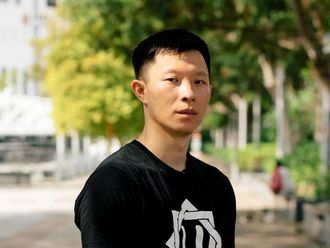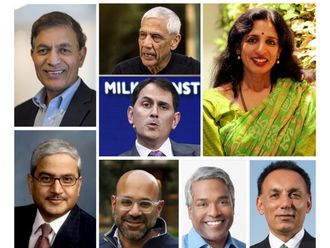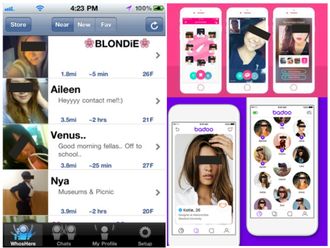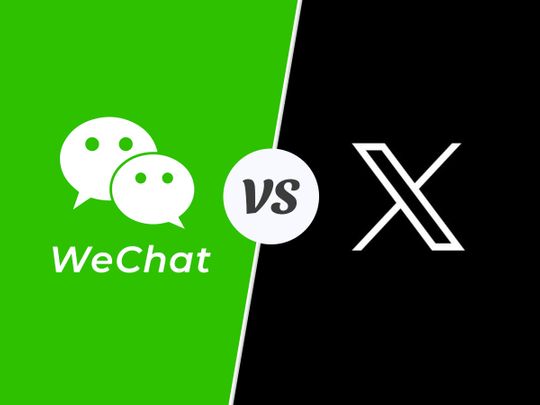
The competition among "everything-apps" is set to get heated up. The cause is the arrival of X, which Twitter hatched.
At least, that is what billionaire Elon Musk intends to accomplish after spending $44 billion to buy the popular microblogging platform, which he renamed X on Monday.
Popular platforms
Twitter/X and WeChat are two well-liked social media platforms. But WeChat has something X doesn’t have and Musk, keenly aware of this deficiency, has made it an aspirational platform to emulate.
WeChat has third-party apps, livestreaming, mobile paymens platform, and digital giving service known as "red packets” — these are key features that make it useful and contribute to its popularity.
Over 10 million third-party apps are available on WeChat. Developed by Tencent, a Chinese company, WeChat is predominantly used in China — with an estimated 1 billion users.
What Elon Musk wants...
Prior to buying, then rebranding Twitter, Musk had declared his admiration for Twitter. He hasn’t hidden his admiration for WeChat, either.
He once told a podcast (check snippet below): “We don’t have an app that is as good as WeChat in China….Like in China, you can live on WeChat, basically… you do payments, you do everything. WeChat is kick-ass. We don’t have anything like WeChat outside of China. So I was like, my idea was: ‘How about if we just copy WeChat'?"
Twitter/X, based in California, currently counts more than 450-million users, and is a more widely used platform globally. A widely dispersed user base is one key thing Twitter/X has, which it could use to its advantage.
WeChat vs X
However, WeChat currently leads the way, in terms of user base. As a super app, WeChat’s flexibility is unmatched, though it’s a relative latecomer in the game.
WeChat has taken the upper hand in global digital payments — opening so many doors for businesses and transactions on the platform.
A number of YouTubers rave about how they were able to link WeChat Pay with their foreign banks, without necessarily securing a Chinese bank account.
WeChat vs X: Similarities/differences
X is poised to enter the finance realm WeChat has completely dominated. It is understood that X’s move would initially target a service rollout in the US, where microblogging has a huge herd of adherents.
What are the similarities and differences between the two? They do have distinct features and purposes:
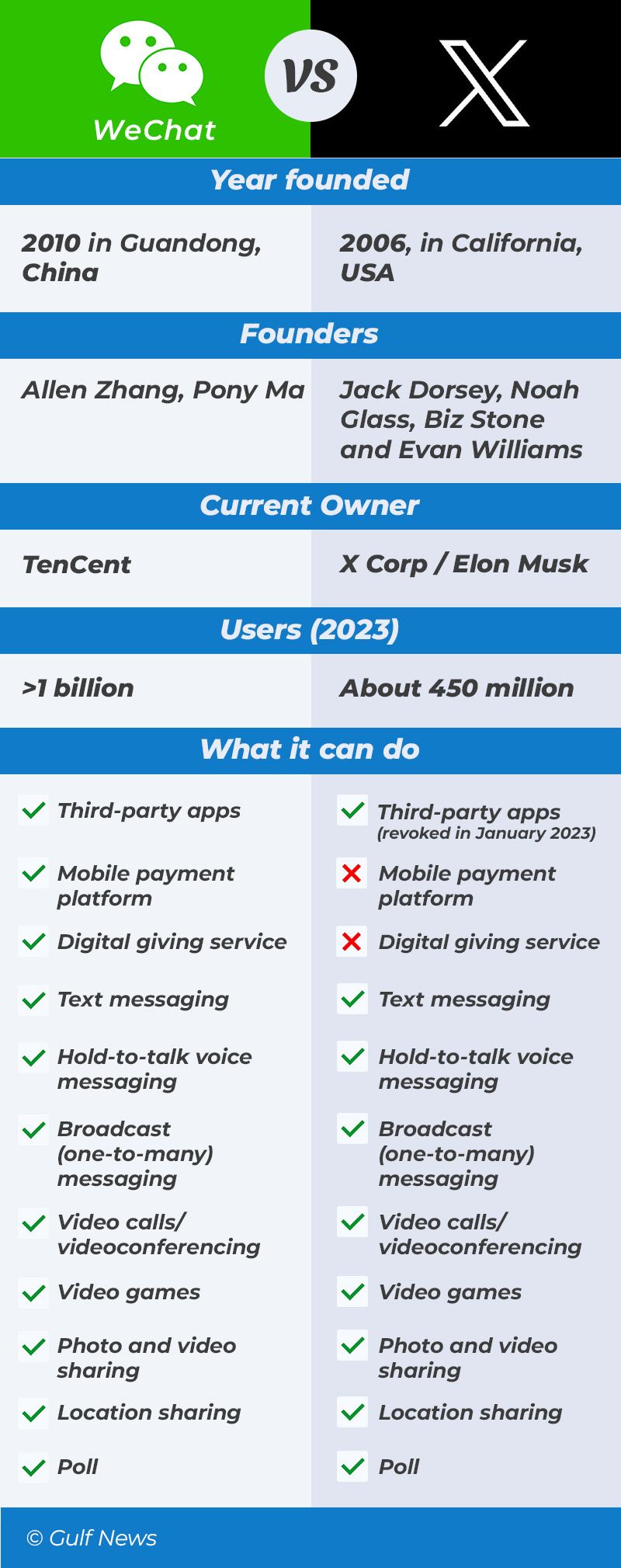
Similarities
Social Networking: Both WeChat and Twitter are social networking platforms that allow users to connect with others, share content, and interact with posts.
Messaging: Both platforms offer messaging capabilities. Twitter allows users to send direct messages (DMs) to each other. WeChat, on the other hand, is primarily known for its messaging features — enabling users to send text messages, voice messages, images, and videos to their contacts.
Content Sharing: On both WeChat Moments and Twitter feeds, users can share content with their followers, such as text updates, photos, and videos.
Made for mobile: Both platforms are primarily used on mobile devices, and they have dedicated apps for iOS and Android.
Differences:
Audience and Reach: WeChat has a large user base primarily concentrated in China, with over a billion active users as of 2021. Twitter, while popular worldwide, has a smaller user base compared to WeChat.
Country of Origin: WeChat is developed by Tencent, a Chinese company, and is predominantly used in China. Twitter, on the other hand, is a US-based platform that is widely used globally.
Features and Functions: WeChat is an all-in-one app that offers a wide range of services beyond social networking — including mobile payments, ride-hailing, food delivery, and more. Twitter (now X), however, focuses primarily on social networking and microblogging, where users can post short messages (tweets) of up to 280 characters (expanded recently for certain users).
Hashtags: X popularised the use of hashtags to categorise and discover content. While WeChat allows the use of hashtags, they are not as central to the platform's functionality as they are on Twitter.
Global vs. Local: X is a global platform used by people from various countries, making it a diverse platform for discussions and news sharing. WeChat, on the othr hand, is mainly used within China and serves as a vital communication tool within the country.
About two-thirds of all users of WeChat are located in China.
Starting at 968.32 million in 2021, the number of active users on WeChat is estimated to reach 1.102 billion by 2025.
On Monday, as part of a wider rebranding, X launched its new logo replacing the familiar blue bird. Musk also replaced his own Twitter icon with a white X on a black background and posted a picture on Monday of the design projected on Twitter’s San Francisco headquarters.
Musk has a penchant for the name “X”. He’s the CEO of rocket company Space Exploration Technologies Corp., known as SpaceX. In 199, he founded the global payments platform PayPal (which was originally created as X.com). Musk has said on many occasions he’s keen to transform Twitter into an “everything app”.
Initially declaring he’s on as a mission to remove bots from Twitter and maintain "free speech," Musk's stated aims for the Twitter acquisition have shifted over time.
Since then, the US billionaire has said Twitter can be a catalyst for bringing about X, his idea for an all-encompassing software similar to WeChat.
Challenges
To be sure, it would take more than a change of logo for Twitter/X to reach what WeChat has achieved.
It’s now in the hands of team of some of the world’s top coders to bring to life the functionalities Musk, himself a competent programmer, envisions. It would include payments and banking alongside audio, video and messaging.
It remains unclear how X’s digital payments functionality would look like. A “beta” version could be announced followed by a live commercial version.
Super app
Social media platforms continue to evolve. Musk’s blueprint for the idea of an “everything app” can be found in Tencent's WeChat itself, and perhaps improve on it.
WeChat has helped transformed China into a digital payments powerhouse. It is the network of choice of more than a billion users to do everything from sending text/photo/video messages and making payments.
Much as apps have redefined phones, an “everything app” could disrupt various industries from banking to global trade. With X, Musk provides a vision of a future different from what we know today.
It represents the potential of the banking ecosystem of the future, uniting messaging, payments, and e-commerce in a single app.
Recently-appointed X CEO Linda Yaccarino explained that X is envisioned as an AI-powered "global marketplace for ideas, goods, services and opportunities."
Ambitious target
What does Twitter/X have that WeChat doesn't have. One could argue: a global hashtag brigade, a loyal base of power users, a microblogging brand used both by individuals and institutions.
For now, Musk’s vision for X can be summed up by what he said recently: “Overtime, it would be HALF of global financial system.” It’s an ambitious target.
Musk has already demonstrated a rare ability to disrupt industries, such as digital payments (with X.com/PayPal), rocketry (with Space X), transportation/energy (with Tesla).
It can be difficult to predict a conclusion in a world where re-branding occurs quickly, AI and computer codes do greatly enhance our lives, and "creative destruction" has become the norm.



